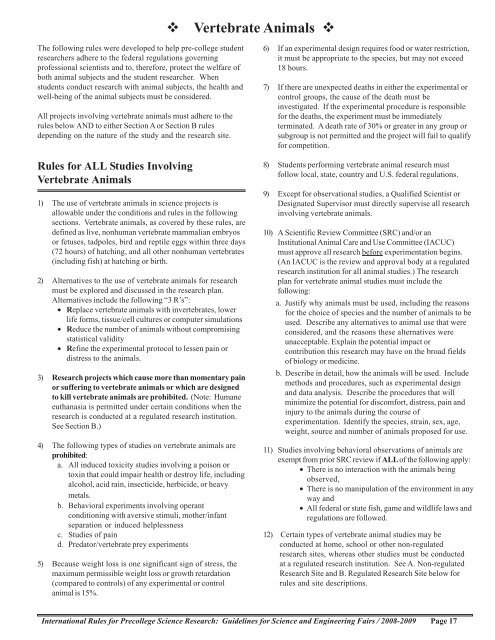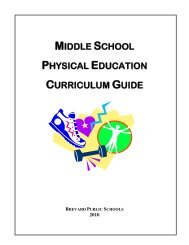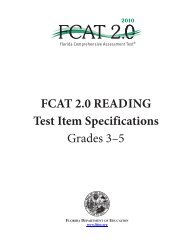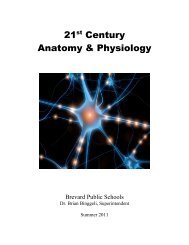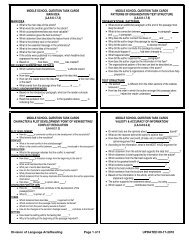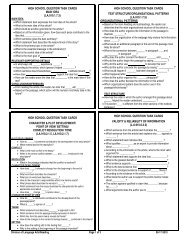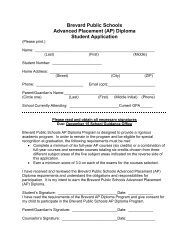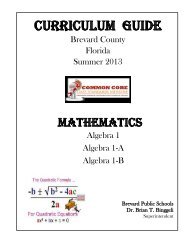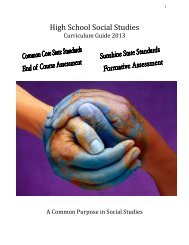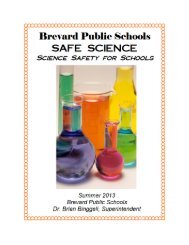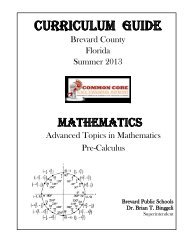Science Research Program Guide - Secondary Programs Home ...
Science Research Program Guide - Secondary Programs Home ...
Science Research Program Guide - Secondary Programs Home ...
You also want an ePaper? Increase the reach of your titles
YUMPU automatically turns print PDFs into web optimized ePapers that Google loves.
The following rules were developed to help pre-college student<br />
researchers adhere to the federal regulations governing<br />
professional scientists and to, therefore, protect the welfare of<br />
both animal subjects and the student researcher. When<br />
students conduct research with animal subjects, the health and<br />
well-being of the animal subjects must be considered.<br />
All projects involving vertebrate animals must adhere to the<br />
rules below AND to either Section A or Section B rules<br />
depending on the nature of the study and the research site.<br />
Rules for ALL Studies Involving<br />
Vertebrate Animals<br />
1) The use of vertebrate animals in science projects is<br />
allowable under the conditions and rules in the following<br />
sections. Vertebrate animals, as covered by these rules, are<br />
defined as live, nonhuman vertebrate mammalian embryos<br />
or fetuses, tadpoles, bird and reptile eggs within three days<br />
(72 hours) of hatching, and all other nonhuman vertebrates<br />
(including fish) at hatching or birth.<br />
2) Alternatives to the use of vertebrate animals for research<br />
must be explored and discussed in the research plan.<br />
Alternatives include the following “3 R’s”:<br />
• Replace vertebrate animals with invertebrates, lower<br />
life forms, tissue/cell cultures or computer simulations<br />
• Reduce the number of animals without compromising<br />
statistical validity<br />
• Refine the experimental protocol to lessen pain or<br />
distress to the animals.<br />
3) <strong>Research</strong> projects which cause more than momentary pain<br />
or suffering to vertebrate animals or which are designed<br />
to kill vertebrate animals are prohibited. (Note: Humane<br />
euthanasia is permitted under certain conditions when the<br />
research is conducted at a regulated research institution.<br />
See Section B.)<br />
4) The following types of studies on vertebrate animals are<br />
prohibited:<br />
a. All induced toxicity studies involving a poison or<br />
toxin that could impair health or destroy life, including<br />
alcohol, acid rain, insecticide, herbicide, or heavy<br />
metals.<br />
b. Behavioral experiments involving operant<br />
conditioning with aversive stimuli, mother/infant<br />
separation or induced helplessness<br />
c. Studies of pain<br />
d. Predator/vertebrate prey experiments<br />
5) Because weight loss is one significant sign of stress, the<br />
maximum permissible weight loss or growth retardation<br />
(compared to controls) of any experimental or control<br />
animal is 15%.<br />
� Vertebrate Animals �<br />
6) If an experimental design requires food or water restriction,<br />
it must be appropriate to the species, but may not exceed<br />
18 hours.<br />
7) If there are unexpected deaths in either the experimental or<br />
control groups, the cause of the death must be<br />
investigated. If the experimental procedure is responsible<br />
for the deaths, the experiment must be immediately<br />
terminated. A death rate of 30% or greater in any group or<br />
subgroup is not permitted and the project will fail to qualify<br />
for competition.<br />
8) Students performing vertebrate animal research must<br />
follow local, state, country and U.S. federal regulations.<br />
9) Except for observational studies, a Qualified Scientist or<br />
Designated Supervisor must directly supervise all research<br />
involving vertebrate animals.<br />
10) A Scientific Review Committee (SRC) and/or an<br />
Institutional Animal Care and Use Committee (IACUC)<br />
must approve all research before experimentation begins.<br />
(An IACUC is the review and approval body at a regulated<br />
research institution for all animal studies.) The research<br />
plan for vertebrate animal studies must include the<br />
following:<br />
a. Justify why animals must be used, including the reasons<br />
for the choice of species and the number of animals to be<br />
used. Describe any alternatives to animal use that were<br />
considered, and the reasons these alternatives were<br />
unacceptable. Explain the potential impact or<br />
contribution this research may have on the broad fields<br />
of biology or medicine.<br />
b. Describe in detail, how the animals will be used. Include<br />
methods and procedures, such as experimental design<br />
and data analysis. Describe the procedures that will<br />
minimize the potential for discomfort, distress, pain and<br />
injury to the animals during the course of<br />
experimentation. Identify the species, strain, sex, age,<br />
weight, source and number of animals proposed for use.<br />
11) Studies involving behavioral observations of animals are<br />
exempt from prior SRC review if ALL of the following apply:<br />
• There is no interaction with the animals being<br />
observed,<br />
• There is no manipulation of the environment in any<br />
way and<br />
• All federal or state fish, game and wildlife laws and<br />
regulations are followed.<br />
12) Certain types of vertebrate animal studies may be<br />
conducted at home, school or other non-regulated<br />
research sites, whereas other studies must be conducted<br />
at a regulated research institution. See A. Non-regulated<br />
<strong>Research</strong> Site and B. Regulated <strong>Research</strong> Site below for<br />
rules and site descriptions.<br />
International Rules for Precollege <strong>Science</strong> <strong>Research</strong>: <strong>Guide</strong>lines for <strong>Science</strong> and Engineering Fairs / 2008-2009 Page 17


